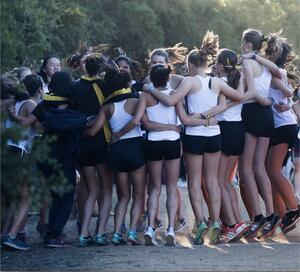Look Fast
I was at a public San Francisco running event with members of my cross country team when we found out Shannon Rowbury, a three-time Olympic runner from San Francisco, was standing right there, amidst a group of runners several feet away. Many of us didn’t know who she was, but a man standing nearby pointed her out in the crowd. Here’s what he said: “I know she doesn’t look that fast, but she’s really good.”
Now, I know this was a well-intentioned comment. I would imagine this man was as awe-struck by Shannon’s abilities as anyone who knows about her accomplishments. But I carried those words around with me for several days after. Look fast. What does that mean? I’ve watched Shannon run—she looks pretty fast.
You might wonder how one could presume to estimate a woman’s speed before she even crossed the starting line. Yet, I am saddened to say that I understand this comment completely. Shannon Rowbury is a shorter person, and she has very muscular legs. She’s not super skinny, and therefore, to some, she doesn’t look fast.
The pressure to “look like a runner” can be immense. A quick Google Images search of “female runner” does not exactly yield a plethora of images of women with curves. The assumed body type of a distance runner is very lean—a pervasive myth that equates being small with being speedy.
Like many of my peers and friends, I have fallen prey to this assumption, equating the unhealthy means of achieving a smaller physique with speed and success. Despite working immensely hard to separate my self-worth from this ideology, there are still times when I feel like I run well in spite of my body, and not because of it. Even as someone who runs 35 miles a week, I sometimes still feel like I don’t belong.
This fall, the women of my cross-country team held an athlete-only meeting about the team’s culture regarding body image and eating disorders. This was my third high school cross country season, and the very first time we had formally acknowledged an issue that so many grapple with on a day-to-day basis. To make that communal recognition was incredibly powerful, saddening, and quite scary.
A 2009 report in the Journal of College Health revealed that over a quarter of American female college athletes demonstrate patterns of disordered eating. However, there is very little research out there on high school athletes. Not all disordered eating habits lead to eating disorders, but nearly all eating disorders stem from disordered eating habits. That’s why when a roomful of my friends said they could in some way relate to this struggle, I felt relieved, but also unnerved.
Even before that team meeting, I had begun to work on a feature article about student-athletes and body image for my school newspaper. Interviewees included a volleyball player who would skip meals out of pressure to look more like her teammates, a tennis and basketball player who could link the fit of her uniform to a decrease in her confidence, and a runner who said that the time period when she “looked most like a runner,” was when she ran her worst.
I had expected my peers to be hesitant and nervous, and to ask for anonymity. But their responses were candid and powerful. The women I interviewed answered my questions full-on, in harsh and matter-of-fact detail, speaking with passion and authority about their stories. I was surprised, but I shouldn’t have been.
I realized that by assuming these would be awkward conversations, I too had internalized the taboo. I thought they would be afraid because I was afraid. Instead, I came away empowered by their strength.
Coincidentally, my article was published this October just four days after a New York Times piece about elite marathoner and body-image advocate Allie Kieffer. In college, Kieffer’s coach suggested that she lose weight, which she did. As a result, her body broke down; she suffered from stress fractures and left the sport. Kieffer is using the platform of her return and rise in distance running as a message that, to quote New York Times author Lindsay Crouse, “when we focus less on fixing what we consider to be inadequacies and more on reinforcing our strengths, we can realize potential we didn’t even know we had.”
The first step the female athletic community, and all communities, can take towards fostering healthier norms is to share stories collectively, to address a pain that is all too common. Sharing—truly communicating what is difficult—leads to understanding, consciousness, advocacy, respect, and real change. By sharing, confronting taboo, making cheeks turn red and ears burn—that’s how we reshape the world.
If you think you or someone you care about is struggling with an eating disorder, contact the National Eating Disorders Association (NEDA) helpline at (800) 931-2237.
This piece was written as part of JWA’s Rising Voices Fellowship.







